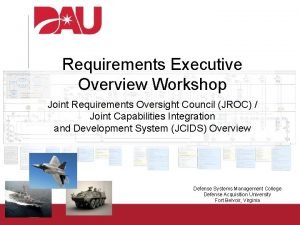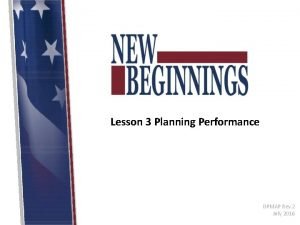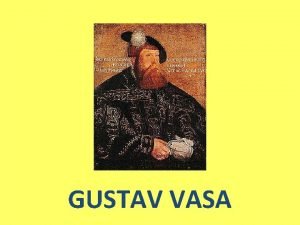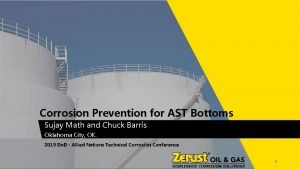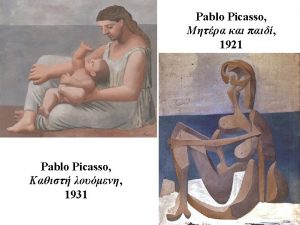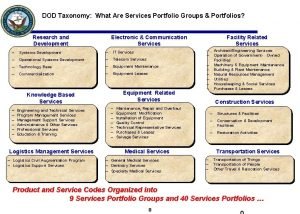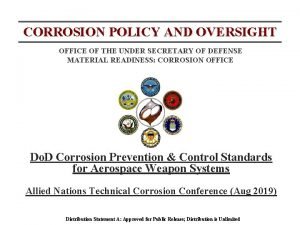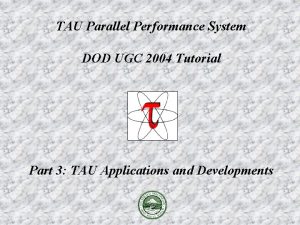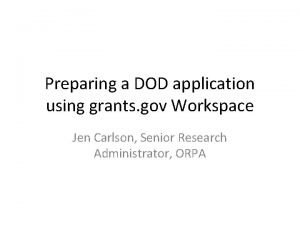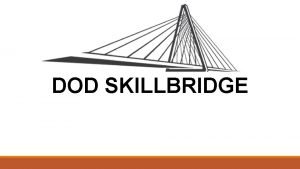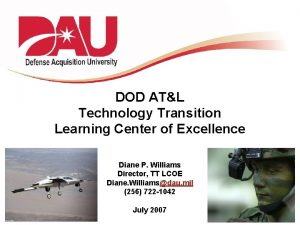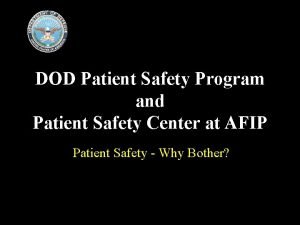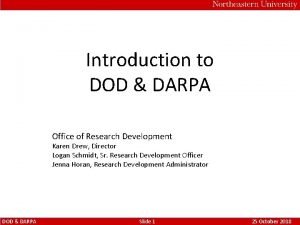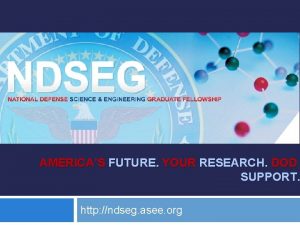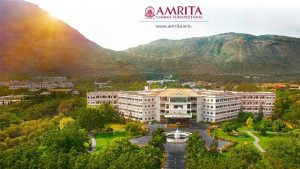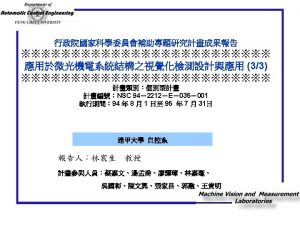Overview of the DOD Center for GeosciencesAtmospheric Research














- Slides: 14

Overview of the DOD Center for Geosciences/Atmospheric Research (CG/AR) at Colorado State University A Cooperative Agreement between Colorado State University (CSU) and U. S. Army Research Laboratory (ARL) in Collaboration with The Naval Research Laboratory (NRL), The Air Force Weather Agency (AFWA), and The US Army Corps of Engineers (USACE) Adapted from the Annual Review Presentation by Professor Tom Vonder Haar CIRA and Department of Atmospheric Science, CSU Recipient Program Manager, CG/AR DOD Center for Geosciences/Atmospheric Research at Colorado State University Smith Briefing 2 June 2010 1

Background of “CG/AR” • • • Began as a competitive DOD University Research Initiative (URI) Award to CSU via ARO in 1986 Multi-disciplinary Research (6. 2 & 6. 1) Normal LOE ~ $2 to 3 M/yr via Cooperative Agreement with ARL Army, Navy, Air Force; Tri-Service focus >120 Graduate/Undergraduate participants over 23 years Graduates continue in DOD research DOD Center for Geosciences/Atmospheric Research at Colorado State University Smith Briefing 2 June 2010 2

Research and Tech Transition Projects are a 4 -Way Match CSU Capabilities DOD Priorities CG/AR Research Project Collaboration Opportunities Available Funding DOD Center for Geosciences/Atmospheric Research at Colorado State University Smith Briefing 2 June 2010 3

Research Projects are Organized into Six Research Themes in an Annual Program Plan (APP) u u u Hydrometeorology Clouds, Icing and Aerosol Effects Environmental Modeling and Assimilation Urban and Boundary Layer Environment Remote Sensing of Battlespace Parameters Technology Transition and Interactions DOD Center for Geosciences/Atmospheric Research at Colorado State University Smith Briefing 2 June 2010 4

Approach to Solutions for DOD Environmental Challenges (Xn) 1. 2. In general use Research-to-Operations-to-Research (R 2 O 2 R) Method CG/AR’s more specific methods: Design & Test Observations Detection or and/or UNDERSTAND Theory the and/or Physics, Dynamics Models Chemistry of Xn Tactical Forecast Methods *Heuristic Guidelines and/or Improved Decision *Xn-Resolving Models Forecasts Aids (TIWEDA) and/or *Advanced Data Assimil. to Models R 2 O 2 R DOD Center for Geosciences/Atmospheric Research at Colorado State University Note: X=environmental variable n=user application Smith Briefing 2 June 2010 5

Using NOAA’s HYSPLIT model, aerosol back trajectories are computed for the Iraq Region. The seasonal dependence (Jan-Feb-Mar (JFM), Apr-May-Jun (AMJ), Jul-Aug -Sep (JAS), and Oct-Nov-Dec (OND)) indicates where aerosols are originating from during that period. Many of these aerosols can carry biological hazards that can affect the long-term health of our soldiers in the field. These model simulations help pinpoint source regions by time and weather events as the DOD works to minimize exposure to potentially harmful bio-aerosols to better protect our soldiers’ health. This is a collaborative effort between the University of Alaska Fairbanks and CSU. (see Kreidenweis and Atwood poster and presentation). DOD Center for Geosciences/Atmospheric Research at Colorado State University Smith Briefing 2 June 2010 6

This figure demonstrates the “brown-out” problem for our warfighters. Even small directional changes of the surface winds can greatly change the anticipated “clear view” for landing purposes. If this craft had landed oriented in the opposite direction pointing into the dust, their fate would have been in doubt. Better understanding of the boundary layer winds and land surface features that affect low level winds are critical to the dust forecasting problem in Iraq and Afghanistan. (ref. Jones et al. (soil moisture) and van den Heever et al. (storm outflow boundaries)). DOD Center for Geosciences/Atmospheric Research at Colorado State University Smith Briefing 2 June 2010 7

Cloud icing is an extreme hazard to aircraft operations. Above is an example of the Cloud Phase/Icing Spatial Correlation Product developed by CG/AR. A key activity is to extend the special Cloud. Sat data from a single narrow beam of data to a larger cloud deck. This horizontally spreads the Cloud. Sat data into important data denied regions. (see Miller et al. poster and presentation) DOD Center for Geosciences/Atmospheric Research at Colorado State University Smith Briefing 2 June 2010 8

Mixed-Phase Cloud Modeling Study (Noh et al. ) 27 km WRF model simulation (ARW-V 3. 1. 1) • Three domains, one way nesting 9 km • Grid: 199 x 139 x 32, Time step (dt): 20 s (d 03) 3 km • • C 3 VP/CLEX-10 Target region • • Four different cloud microphysics versions RRTM long-wave radiation scheme Dudhia short-wave scheme Noah land-surface model YSU PBL scheme Initialization & boundary conditions : GFS 1835 -1915 UTC (Valid 1900 UTC 05 Nov 2006 , WDM 6≈WSM 6, interpolated 500 m vertical resolution) All model runs predict the supercooled water too low; 3 of 4 models have incorrect ice/water ratio DOD Center for Geosciences/Atmospheric Research at Colorado State University Smith Briefing 2 June 2010 9

Battlespace Products u Middle East Products LINK u Flooding Products Blended Total Precipitable Water LINK t Orographic Rain Index LINK t DOD Center for Geosciences/Atmospheric Research at Colorado State University Smith Briefing 2 June 2010 10

Lt. Col. Brian Griffith (CSU Graduate) discusses battlefield weather capabilities with Capt. Jacob Chisolm at Bagram Airfield, Afghanistan. Colonel Griffith is the 19 th Expeditionary Weather Squadron commander (Meteorological Technology International 2010, pp. 44 -45). CSU Students who interact with our CG/AR DODfocused faculty and staff go on to make important contributions for our nation. DOD Center for Geosciences/Atmospheric Research at Colorado State University Smith Briefing 2 June 2010 11

Overview of the DOD Center for Geosciences/Atmospheric Science (CG/AR) at Colorado State University 2009 -10 …. . The 23 rd Year 1. 2. 3. 4. 5. 6. In our 6 Theme Areas of CG/AR we have: Enhanced our studies of Hydrometeorology and Soil Moisture in collaboration with ARL and ERDC; developed “ponding” research leading to TDA’s Continued our Leading Research on Clouds and Aerosols related to Cloud and Icing Forecasts, CFLOS, etc. Provided new regional and local Modeling and Assimilation Research Results including Direct Satellite Radiance Assimilation, Theory for Lognormal Variables and Cloud Nowcasting Enhanced our studies of the Boundary Layer Environment Wind Fields in the Middle East, remote coastal Stratocumulus regions, Acoustic Transmission Loss Continued studies of Battlespace Environment Clouds, Water Vapor and Precipitation related to improved forecasting in data-denied regions Continued Tech Transmission and DOD Lab Interactions with Visits, BACIMO papers, etc. DOD Center for Geosciences/Atmospheric Research at Colorado State University Smith Briefing 2 June 2010 12

Level of Effort under the CG/AR Cooperative Agreement with ARL Hydrometeorology Clouds, Icing and Aerosol Effects Environmental Modeling and Assimilation 06 -07 (historic) 09 -10 (actual) 10 -11 (expected) $2. 5 M $1. 6 M $2. 7 M 14% (2 students) 20% (3 students) 14% (2 students) 15% (1 student) 13% (1 student) 29% (1 student) 20% (1 postdoc) 15% (1 postdoc) DOD Center for Geosciences/Atmospheric Research at Colorado State University Smith Briefing 2 June 2010 13

Level of Effort under the CG/AR Cooperative Agreement with ARL (cont’d) Urban and Boundary Layer Environment Remote Sensing of Battlespace Parameters Technology Transition and Interactions 06 -07 (historic) 09 -10 (actual) 10 -11 (expected) $2. 5 M $1. 6 M $2. 7 M 8% (1 student) 15% (3 students) 20% (5 students) 14% (2 students) 10% (2 students) 12% (2 students) 21% (1 student) 20% (4 -5 students) DOD Center for Geosciences/Atmospheric Research at Colorado State University Smith Briefing 2 June 2010 14
 How did juda die
How did juda die Dod cio organization chart
Dod cio organization chart Dpmap performance elements
Dpmap performance elements Gustav vasas barndom
Gustav vasas barndom Dod evmig
Dod evmig Articles of the code of conduct
Articles of the code of conduct Dod patient safety program
Dod patient safety program Dod digital engineering strategy
Dod digital engineering strategy 2019 dod allied nations technical corrosion conference
2019 dod allied nations technical corrosion conference Fss muni percentil posledního přijatého
Fss muni percentil posledního přijatého Picasso dod
Picasso dod Dod taxonomy
Dod taxonomy Mil-std-1530d
Mil-std-1530d Dod
Dod Dod workspace
Dod workspace

